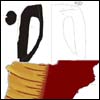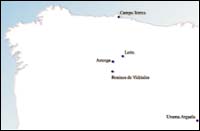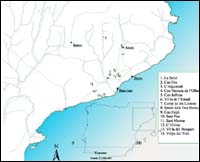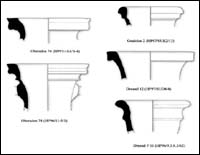|
The amphora circulation in the Tarraconense
conventus Asturum, central Catalonia and Barcino |
|
|
Prof. Dr. César Carreras Monfort (UOC) Funded by: Junta de Castilla y León; Generalitat de Catalunya i Secció d'Arqueologia Urbana (Barcelona) |
|
In 1994 we carried out a first study of the amphora material coming from Campa Torres excavations (Gijón). Due to this initial contact, we became interested in the amphora circulation in the Northwest quadrant of the Peninsula. This is quite an attractive region in the Roman period because of the important presence of the army and mining exploitations. During two years a series of amphora assemblages of Roman sites from Castilla and León were studied, so they allowed us to have a fair idea of their distribution in the conventus Asturum. Meanwhile, in 1995, a systematic study of amphora assemblage coming from different sites in Catalonia was set up. It included urban centres (such as Ausa, Iluro, Iesso) as well as rural sites of lower rank such as El Bosquet vila, Can Feu vila or Can Ventura de l'Oller vila. As a result of this work, it became necessary to analyse a larger amphora assemblage, that is why we decided in 1996 to study the amphorae of Barcino, which is still under way. Aims of the Project
Particular Studies
|
|
Bibliography Berni Millet, P. (1996). "Instrumentum domesticum romà del Museu Episcopal de Vic. La col·lecció de segells en àmfora, tegula i morter". Pyrenae 27; pp.311-326. Carreras Monfort, C. (1996). "El comercio de Asturia a través de las ánforas". C. Fernández Ochoa (coord.). Los Finisterres atlánticos en la Antigüedad. Gijón; pp.205-212. Carreras Monfort C. (1997). "Los beneficiarii y la red de aprovisionamiento militar de Britannia e Hispania". Gerión 15; pp.151-176. Berni Millet, P. (1998). "Las ánforas de aceite de la Bética y su presencia en la Cataluña romana". Col.lecció Instrumenta nº 4. Barcelona. Berni Millet P., Carreras Monfort C., Revilla Calvo V. (1998). "Sobre dos nuevos Cornelii del vino tarraconense". Laietania 11; pp. 111-123. Carreras Monfort C., Berni Millet P.(1998). "Producció de vi i àmfores tardanes del NE de la Tarraconense". En II Col·loqui Internacional d'Arqueologia Romana. El vi a l'Antiguitat. Badalona; pp.270-276. Guitart, J., Pera J., Carreras C. (1998). "La presència del vi itàlic a les fundacions urbanes del principi del segle I aC a l'interior de Catalunya: l'exemple de Iesso". En II Col·loqui Internacional d'Arqueologia Romana. El vi a l'Antiguitat. Badalona, pp.39-60. Berni Millet P., Carreras Monfort C. (2001). "El circuit comercial de Barcino: reflexions al voltant de les marques amfòriques". Faventia 23/1, 2001; pp. 103-129. Carreras Monfort C., Berni Millet P. ( 2002 ). "Microspatial relationships in the Laietanian wine trade: shipwrecks, amphora stamps and workshops". Vivre, produire et échanger: reflets méditerranéens. Mélanges offerts à Bernard Liou. Textes rassamblés par Lucien Rivet et Martine Sciallano. Archaéologie et histoire romaine 8. Éditions Monique Mergoil Montagnac; pp. 359-369. Olesti i Vila O., Carreras Monfort C. ( 2002 ). "Denominació d'origen M. Porci: reflexions al voltant d'una marca d'àmfora tarraconense". Laietania 13; pp. 177-190. Carreras Monfort C., Berni Millet P. ( 2003 ). "Ánforas". Astorga IV . Lucernas y ánforas. Amaré Tafalla (Dir.). Universidad de León. pp. 653-673. Pujol i Hamelink M, Carreras Monfort C. (2003). "L'ancoratge i el port de Rhode (Roses, Alt Empordà)". Empúries, 53 (2002), pàgs. 131-154. Carreras Monfort C. (2004). "Les àmfores de Iesso". Guitart Duran, J.; Pera Isern, J. (ed.), Iesso I. Miscel·lània Arquològica. Patronat d'Arqueologia de Guissona, pp. 145-169. Carreras Monfort C., Berni Millet P. (2005). "Late Roman amphorae in the City of Barcino (Barcelona)". Gurt i Esparraguera J.M., Buxeda i Garrigós J., Cau Ontiveros M.A. (ed.), LRCW I, Late Roman Coarse Wares, Cooking Wares and Amphorae the Mediterranean. Archaeology and Archaeometry, BAR International Series 1340, 2005, pp. 165-178. Berni Millet P., Carreras Monfort C., Olesti i Vila O. (2005). "La gens Licinia y el nordeste peninsular. Una aproximación al estudio de las formas de propiedad y de gestión de un rico patrimonio familiar". Archivo Español de Arqueología, 78, nrs. 191-192; pp. 167-187. Aguelo i Mas J., Carreras Monfort C., Huertas Arroyo J. (2006). "L'ocupació altimperial del solar del Mercat de Santa Caterina. Un possible centre productor ceràmic". QUARHIS, época II, núm. 2; pp. 60-73. |




